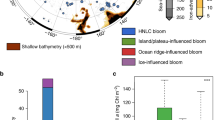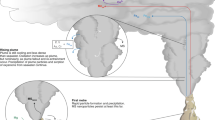Abstract
Hydrothermal particles originate in buoyant plumes emanating from seafloor thermal vents1–4 and accumulate as metalliferous sediments found along oceanic spreading centres5–7. Observational evidence of the transport pathway of hydrothermal particles is scarce, however, and the structure, extent and particle concentrations of hydrothermal plumes remain largely conjectural. To evaluate the potential of hydrothermal plumes as particle transport agents, we mapped their distribution along and across the 80–100-m-deep axial valley of the southern Juan de Fuca Ridge in the north-east Pacific Ocean (∼44°30′ N, 130° W), an area of known hydrothermal activity8–11. Continuous light-scattering measurements, reported here, defined numerous particle plumes centred 30–120 m above bottom (m.a.b.); elemental analysis of the plume particles and the theta (potential temperature)–S (salinity) signatures of the plume water verified their hydrothermal origin. Concentrations of hydrothermal particles remained elevated at ridge-crest depths at least 100 km from the ridge, indicating distant off-axis dispersal of hydrothermal emissions.
This is a preview of subscription content, access via your institution
Access options
Subscribe to this journal
Receive 51 print issues and online access
$199.00 per year
only $3.90 per issue
Buy this article
- Purchase on Springer Link
- Instant access to full article PDF
Prices may be subject to local taxes which are calculated during checkout
Similar content being viewed by others
References
Corliss, J. B. et al. Science 203, 1073–1083 (1979).
Lupton, J. E. et al. Earth planet. Sci. Lett. 50, 115–127 (1980).
Edmond, J. M., Von Damm, K. L., McDuff, R. E. & Measures, C. I. Nature 297, 187–191 (1982).
Campbell, A. C. & Gieskes, J. M. Earth planet. Sci. Lett. 68, 57–72 (1984).
Bostrom, K. & Peterson, M. N. A. Econ. Geol. 61, 1258–1265 (1966).
Bostrom, K., Peterson, M. N. A., Johnson, O. & Fisher, D. E. J. geophys. Res. 74, 3261–3270 (1969).
Dymond, J. Mem. geol. Soc. Am. 154, 133–173 (1981).
Delaney, J. R., Johnson, M. P. & Karsten, J. L. J. geophys. Res. 86, 11747–11750 (1981).
Normark, W. R. et al. Geology 11, 158–163 (1983).
Normark, W. R. et al. EOS 66, 116 (1985).
Crane, K. et al. J.geophys. Res. 90, 727–744 (1985).
Feely, R. A., Massoth, G. J. & Landing, W. M. Mar. Chem. 10, 431–453 (1981).
Baker, E. T. & Milburn, H. B. Cont. Shelf Res. 1, 425–435 (1983).
Leinen, M. EOS 65, 1112 (1984).
Lupton, J. E. & Craig, H. Science 214, 13–18 (1981).
Klinkhammer, G. P. Chem. Geol. 29, 211–226 (1980).
Author information
Authors and Affiliations
Rights and permissions
About this article
Cite this article
Baker, E., Lavelle, J. & Massoth, G. Hydrothermal particle plumes over the southern Juan de Fuca Ridge. Nature 316, 342–344 (1985). https://doi.org/10.1038/316342a0
Received:
Accepted:
Issue Date:
DOI: https://doi.org/10.1038/316342a0
This article is cited by
-
Textural, mineralogical, and geochemical characteristics of non-volcanogenic Fe–Mn deposit of Motuosala, western Tianshan, northwestern China
Arabian Journal of Geosciences (2020)
-
A multi-channel chemical sensor and its application in detecting hydrothermal vents
Acta Oceanologica Sinica (2019)
-
Caldera formation and varied eruption styles on North Pacific seamounts: the clastic lithofacies record
Bulletin of Volcanology (2014)
-
Suspended zinc sulfide particles in the Southwest Indian Ridge area and their relationship with hydrothermal activity
Chinese Science Bulletin (2014)
-
Study on the high precision acoustic measurement techniques for determining temperature field around seafloor hydrothermal vent
China Ocean Engineering (2012)
Comments
By submitting a comment you agree to abide by our Terms and Community Guidelines. If you find something abusive or that does not comply with our terms or guidelines please flag it as inappropriate.



